

![]()
INTRODUCTION TO BORDER COLLIE COUSINS
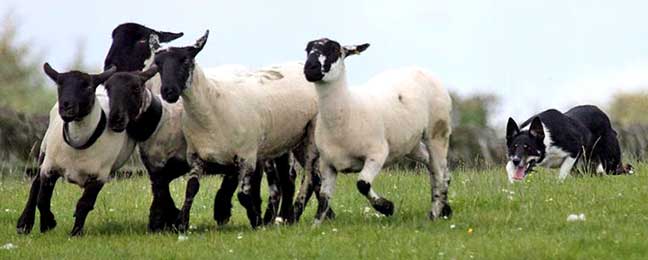
Angie Driscoll's Border Collie Kinloch Penny on the drive at Mynyddisywn SDT 2011.
(Photo ©Kinloch Sheepdogs, reprinted with kind permission.)
Penny displays the typical herding style of the Border Collie:
tail down, head down, belly close to the ground, creaping forward, and using "eye" to move the stock.
The tree, below, was originally designed by Linda Rorem who is a herding dog historian, one of the founder of the American Herding Breeds Association,
an all-breeds herding trials Judge, and the custodian of the website, Herding on the Web (www.herdingontheweb.com).
The tree has been modified more than once by the Carole Presberg (and others) with Linda's kind permission.
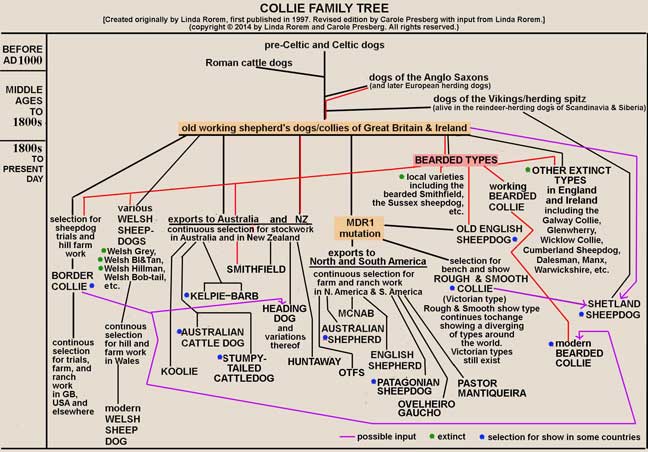
[Please note: this tree shows the historic relationships between contemporary collie breeds. A chart such as this must be in a simplified form. There have undoubtedly been other lesser influences from time to time on the various collie breeds, but even major influences become diluted with time. Also, many breeds other than the collie breeds have descended from Roman cattle dogs, herding spitzes, Celtic dogs, etc. This tree only shows the collies and collie-related breeds and types which have the old working shepherds' dogs/collies of Great Britain and Ireland as their primary ancestors. Furthermore, it does not imply that originally there was only one type of shepherd's dog. Types varied between and within regions, as well as having similarities across regions, a situation that is too complicated to be shown on this simple relationship chart.]
(Please scroll toward the bottom to see an explanation of the MDR1 MUTATION mentioned in the tree)
See THE HISTORY OF THE SHEPHERD'S DOG GLOSSARY
for an explanation of the terms used in these articles
The tree shows historic relationships between contemporary collie breeds. There have been other, lesser influences from time to time. Also, many breeds other than collie breeds have descended from the Roman cattle dogs, herding spitzes, Celtic dogs, etc. This tree only shows the collie-related breeds, which have the old working collies of Great Britain as their primary ancestors. There have been similar breeds on the Continent. Types varied, sometimes greatly, between and within regions, as well as having commonalities within and across regions.
For some, the term "collie" may seem a misnomer and the term "shepherd's dog" might fit better. Nevertheless, the terms "collie", "shepherd's dog", and "sheepdog" or "sheep dog" have been used interchangeably throughout much of the history of pastoral dogs in Britain, with some people using one term and others using another. The tree should explain how these breeds and types may be considered cousins. It does not include the herding dogs of Europe and Asia, though these dogs may also be considered at least distant cousins, and some may have had the same roots or at least similar ones, and we will look at these breeds and types as well in this series of articles.
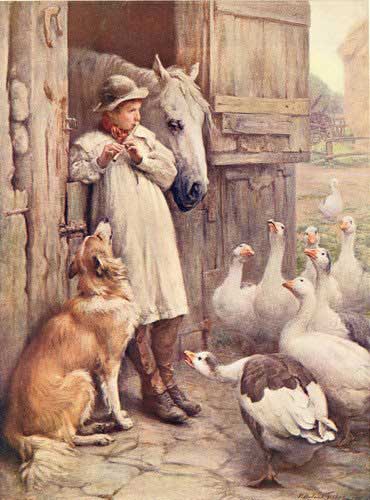 Left, "Sympathetic Listeners" by Percy Harland Fisher (1867-1944)
Left, "Sympathetic Listeners" by Percy Harland Fisher (1867-1944)
The ancestors of herding dogs were as diverse in looks as the Border Collie is today, and more so; and they were equally diverse in working style. Farmers, shepherds, and drovers selected and bred their dogs for the kinds of work for which they needed them, but also by personal preference, and no less according to what was available to them in their sometimes remote and isolated areas.
Why is genetic diversity important? It plays a role in the survival and adaptability of species. With more variation, it is more likely that some individuals in a population will possess genes best suited for the environment. It also serves as a way for populations to adapt to changing environments. Most breeds of dogs have been artificially selected for a particular set of looks and/or for behaviors for specific roles. This narrows gene pools. Species with very little genetic variation are at great risk. As gene pools narrow, vulnerability to diseases increases. Without genetic diversity, quite simply, a species will eventually become extinct. All dogs, however, belong to the same species, and it is the most varied species of land animal; so in the case of dogs, the species is unlikely to go extinct.
Nevertheless, diversity assures availability of role-suitable and environment-suitable types of dogs, producing landraces and ensuring that there will be a wide range of herding types accessible into the future. A landrace is a variety of domestic animal which has developed by adaptation to the natural and cultural environment in which it lives. A landrace differs from a formal breed which has been bred purposely to conform to a particular type. Landraces are commonly more genetically and physically diverse than formal breeds.
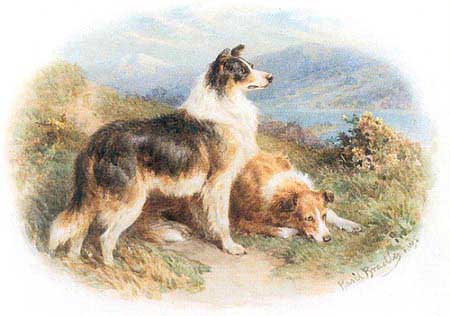
Above, two early show-type collies
by English artist Basil Bradley (1842-1904)
There are fourteen registered "collie breeds" (including the Border Collie) in existence today that deveopled from old working collies and shepherd's dogs in Britain: the Australian Shepherd, the Australian Kelpie, the Australian Cattle Dog (a.k.a. Blue Heeler or Queensland Heeler), the Stumpytailed Cattle Dog, the Collie (both Rough and Smooth), the AustralianKoolie (a.k.a. Coolie or German Coolie), the English Shepherd, the Old English Sheepdog, the McNab, the Shetland Sheepdog, the Bearded Collie, the Welsh Sheep Dog and the Old Time Farm Shepherd (which is really a type rather than a breed but is registered).
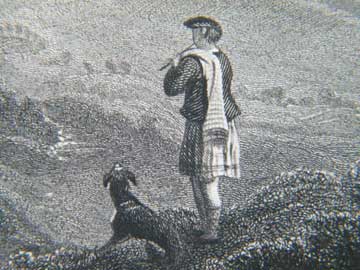 Right, an 1860 steel-cut engraving of a Scottish shepherd playing a pennywhistle, with his sheepdog at his side. (Artist unknown.)
Right, an 1860 steel-cut engraving of a Scottish shepherd playing a pennywhistle, with his sheepdog at his side. (Artist unknown.)
To this we have added several that are not yet registered: the Smithfield, the Ovelheiro Gaucho, the Patagonian Sheepdog, and the Pastor Mantiqueira. Currently, owners of dogs in Tasmania (Australia) that might be called Smithfields are rallying to define this type of dog as a breed and form an association and perhaps a registry. We applaud this move, but hope that the Smithfields they are reviving are indeed working dogs. In the history of the shepherd's dog, the Smithfield was never a single breed. When drovers brought their sheep and cattle to Smithfield Market in London they were accompanied by a variety of dogs. Eventually, the drovers' dogs became associated with the market and ultimately became known as "Smithfields". But, and here I have to defer once again to Linda Rorem, the bearded or shaggy coats were just one type of coat that these dogs sported, though it was this bearded coat that eventually became associated with the dogs in some parts of the British Isles. The Smithfield in Tasmania also includes many different types, but they all seem to be bearded types.
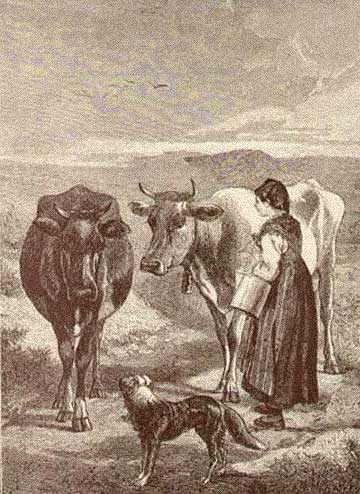 An engraving from the 1880s called "When the Cows Come Home", which shows a milking maid bringing the cows home with the help of her collie dog. I'm sure you are wondering why she is carrying a milk pail when she is bringing them home to be milked. The pail is just an artist's device to identify the woman as a milk maid. (Artist unknown.)
An engraving from the 1880s called "When the Cows Come Home", which shows a milking maid bringing the cows home with the help of her collie dog. I'm sure you are wondering why she is carrying a milk pail when she is bringing them home to be milked. The pail is just an artist's device to identify the woman as a milk maid. (Artist unknown.)
In New Zealand there are interesting named "non-breeds": the Smithfield, the Huntaway, the Heading or Eye Dog, and the Backing Dog. We will also talk about these. And we will talk about extinct breeds or types, specifically, a handful of extinct British breeds, the Barb in Australia, the working collies of Ireland, and some of the extinct working collies of Wales.
In addition, I have added pages on the herding breeds or types of Europe and Asia. While most can not be said to actually be "Border Collie cousins", some may in fact be, at least distant cousins, but this has not yet been proven. Others appear to be very different. Perhaps I should have renamed these pages, and perhaps some time in the future I will. But for now, all the herding breeds/types covered here live at "Border Collie Cousins".
In the articles that follow, when I am speaking about a breed, that is a "formally recognized group of dogs genetically isolated from other groups of dogs by a breed registry", I use uppercase letters for the leading character(s) in the name (for example, "the Rough Collie"). When I am speaking about a type of dog, or group of types, I use lowercase letters for the leading character(s) in the name (for example, "the old working collies"). In all cases where there is a working type and a show type that share the same name but not the same registry (for example, "the Border Collie"), please assume that I mean the working type unless otherwise indicated. In the case where a local variety may have become named even if it never had a registry (for example, "the Welsh Grey"), or when quoting someone who uses this convention, although this can get confusing, I have bowed to convention and used capital leading characters.
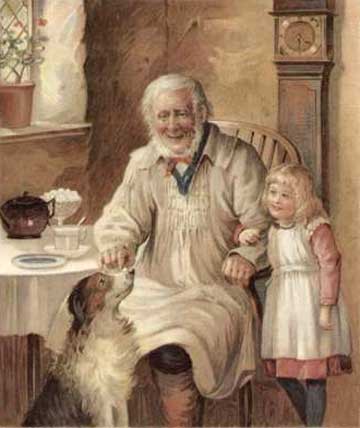 An 1896 painting (artist unknown) shows an elderly English shepherd (identified by his smock) showing his young granddaughter a trick that his tri-colored collie can do. He is placing a lump of sugar on the dog's nose, and if we can see into the future of this delightful scene, it is likely that the dog will wait for a signal and then flip the sugar into the air and catch it in his mouth.
An 1896 painting (artist unknown) shows an elderly English shepherd (identified by his smock) showing his young granddaughter a trick that his tri-colored collie can do. He is placing a lump of sugar on the dog's nose, and if we can see into the future of this delightful scene, it is likely that the dog will wait for a signal and then flip the sugar into the air and catch it in his mouth.
Coat colors are often called by different names in different breeds and even by different names in the same breed in different countries. Case in point is the color those of us in Great Britain and the USA call "red" in Border Collies. In Australia, this color is called "brown" or "chocolate". Dogs that in Great Britain and the USA are called "tan", are called "red" in Australia. I have tried to compare a color to what it is called in the Border Collie. This may still seem confusing, because tan and sable, for example, are not genetically the same color (the genes that produce them are on different alleles), but in some breeds both colors are called by the same name. For example, in the English Shepherd, tan and sable are called by the same name. Tan is called "clear sable", sable is simply called "sable" (or "shaded sable"), and dark sable, where the tan only shows when you part the hair, is called "heavily shaded sable". This latter may have actually been the color of Auld Hemp, who had sometimes been described as being like "the color of an old, tarred hawser; though it looks black, when you untwist the rope, you can see the tan below". There is an excellent article on dog coat genetics on Wikipedia, http://www.en.wikipedia.org/wiki/Coat_(dog).
About coat type: It is generally thought that smooth is dominant over rough. Two smooths can produce a rough, but two roughs cannot produce a smooth. Smooths carrying the "rough factor" often have a more full coat, though there are other modifiers involved for texture and length, etc. Bearded and/or wire coat is on a different locus, and is dominant over non-bearded, so both rough and smooth-coated dogs could, in theory, be bearded, but on smooth coats there probably isn't usually enough hair to show a beard. However, sometimes a smooth-coated dog might show a little "mustache" or a slight emphasis on the cheeks, etc., which would indicate he was carrying a gene for beardedness. One other point is that the gene for bearded is the same one that produces wire haired coats in other breeds, but most wire-haired breeds have short coats. There are also gene modifiers at work on both coat type and coat color. It isn't straightforward.
|
↓ click here for ↓
|
EXPLANATION of the MDR1 MUTATION
In 2004, Mark W. Neff, a veterinary geneticist at the School of Veterinary Medicine, University of California, Davis, and seven colleagues [1], wrote an article [2] for inclusion in PNAS [3]. In it they explained how their study determined that a mutation, found in the collie lineage, caused a sensitivity to certain drugs (including ivermectin). Based on breed histories, they concluded that all dogs that carry this mutation "are descendants of a dog that lived in Great Britain before the genetic isolation of breeds by registry (ca. 1873)." The mutation's history, they say "recounts the emergence of formally recognized breeds from an admixed population of working sheepdogs." [4]
The authors used Linda Rorem's "Collie Family Tree" (above) to select "collie-related breeds for testing" and say that it "was generally predictive of the observed distribution of [the mutation and t]he mutation was not found in any of the herding breeds whose origins traced back to continental Europe."
The authors had done their homework [5] on the history of the collie breeds:
Dogs carrying [the mutation] share a common ancestor that experienced remarkable evolutionary success, having contributed genetically to at least nine distinct breeds of dog. We propose that this animal lived in Great Britain in the 1800s, before the emergence of formal breeds. Before 1870, there were no established registries for sheepdogs, only regional varieties of working dogs that had been adapted to terrain, climate, breed of sheep, and working style. Industrialization in the 19th century brought changes in trade and transportation that may have facilitated admixture among these varieties. Socioeconomic changes almost certainly altered the role of working dogs because they were no longer needed to drive sheep over long distances to market. Although a few specialized strains rose in prominence, perhaps aided by success at field trial events, many strains such as the Galway Collie, the Dalesman, the Manx Sheepdog, and the Welsh Gray gradually began to disappear. The neglect of regional varieties may have contributed directly to the advent of dog shows, which aimed to preserve and restore strains by emphasizing form rather than function. The first bench show to admit herding dogs took place in Birmingham in 1860, with one class open to all "sheepdogs, colleys, yard, or keeper's dogs." This show marked the beginning of an important transition in the history of sheepdogs, from regional variety to registered breed, and from anonymous working dog to pedigreed purebred.
From the point of view of the history of the Border Collie, this is an important study. Although some Border Collies do have a sensitivity to ivermectin, the mutation was not found in the Border Collie, so this study and it's findings, though not conclusive in this area, indicate that the Border Collie broke off from the rest of the population of old working collies of Great Britain and Ireland prior to the mutation. Collies, Australian Shepherds, Shetland Sheepdogs, English Shepherds, the McNab, and Old English Sheepdogs, all share a lineage that exhibits the mutation. The mutation was also not found in the Bearded Collie or Australian Cattle Dog.
NOTES:
[1] Kathryn R. Robertson, Aaron K. Wong, Noa Safra, Karl W. Broman, Montgomery Slatkin, Katrina L. Mealey, and Niels C. Pedersen.
[2] Neff et al, "Breed distribution and history of canine mdr1-1 a pharmacogenetic mutation that marks the emergence of breeds from the collie lineage", PNAS, August 10, 2004, Vol. 101, No. 32, pps. 11725-11730.
[3] The Proceedings of the National Academy of Sciences of the United States of America, "one of the world's most-cited multidisciplinary scientific serials," established in 1914, publishes cutting-edge research reports.
[4] See the abstract of the article.
[5] They reference Combe, I. (1987) Herding Dogs, Their Origins and Development in Britain (Faber & Faber Ltd., London) and Gosset, A.L.J. (1911) Shepherds of Britain: Scenes from Shepherd Life Past and Present from the Best Authorities (Constable and Co., Ltd., London)
THE OTHER WEB PAGES WE MAINTAIN
These web pages are copyright ©2014
and maintained by webmeistress Carole Presberg
with technical help from webwizard David Presberg
ALL RIGHTS RESERVED
If you are interested in using ANY material on this website, you MUST first ask for permission.